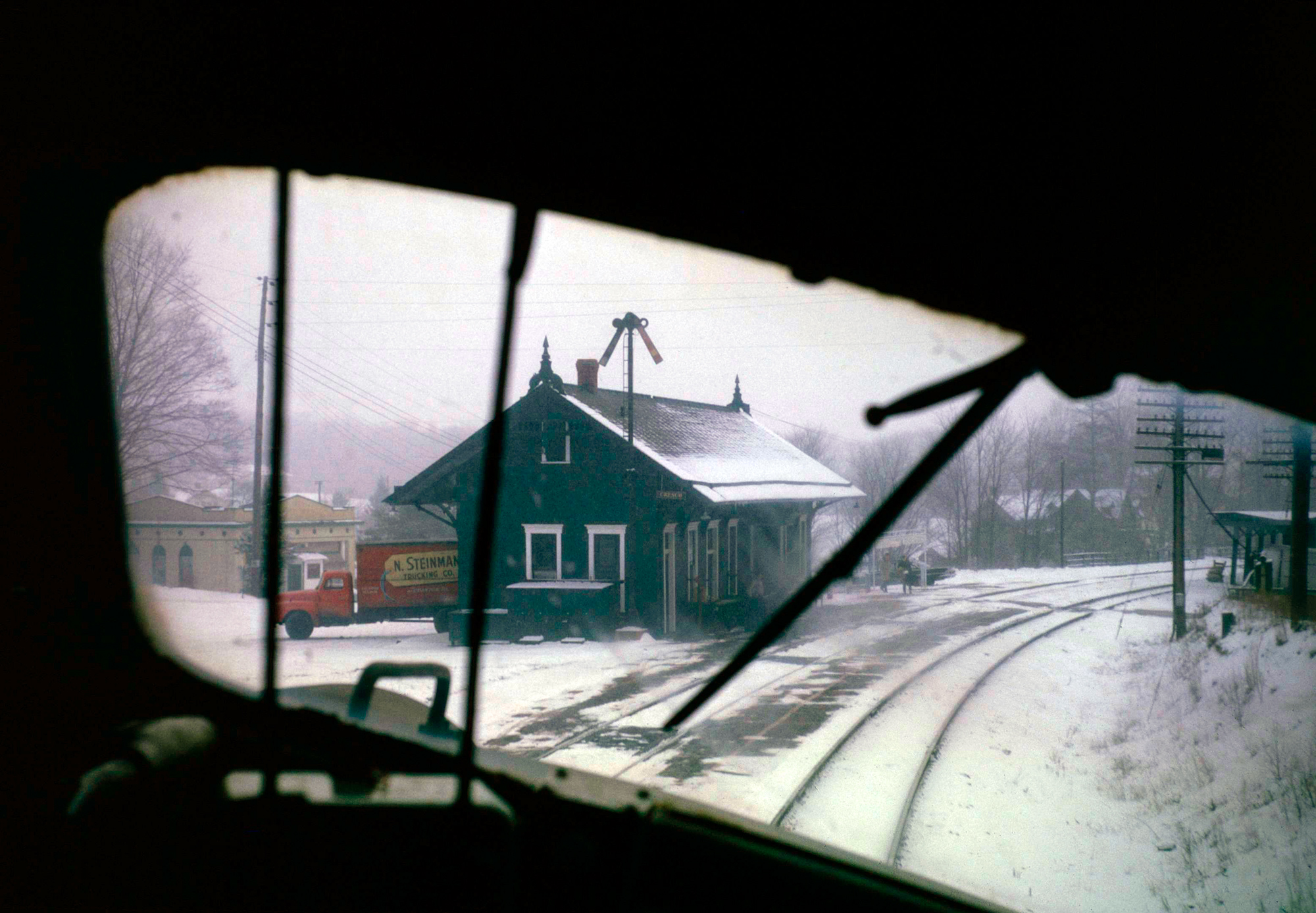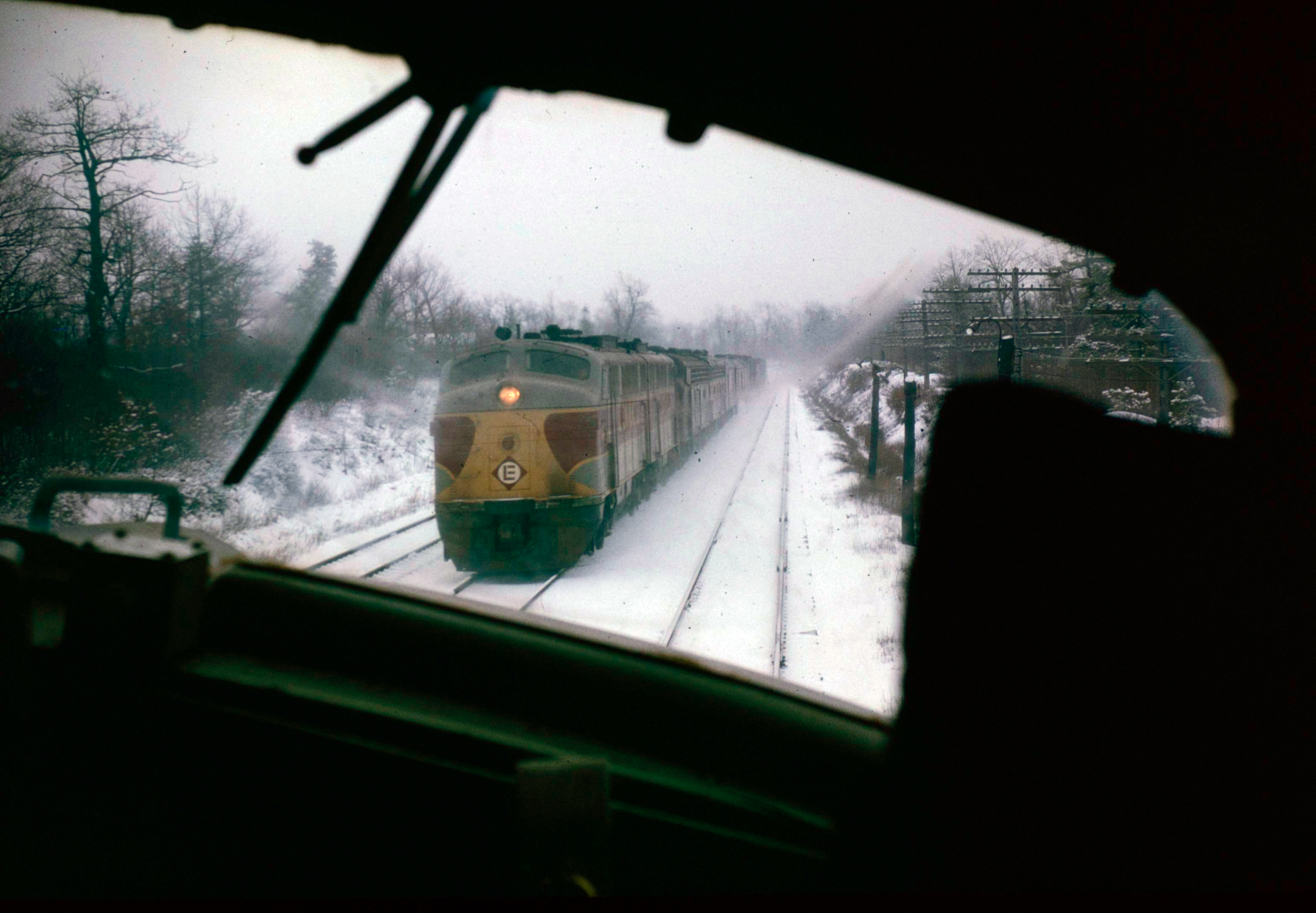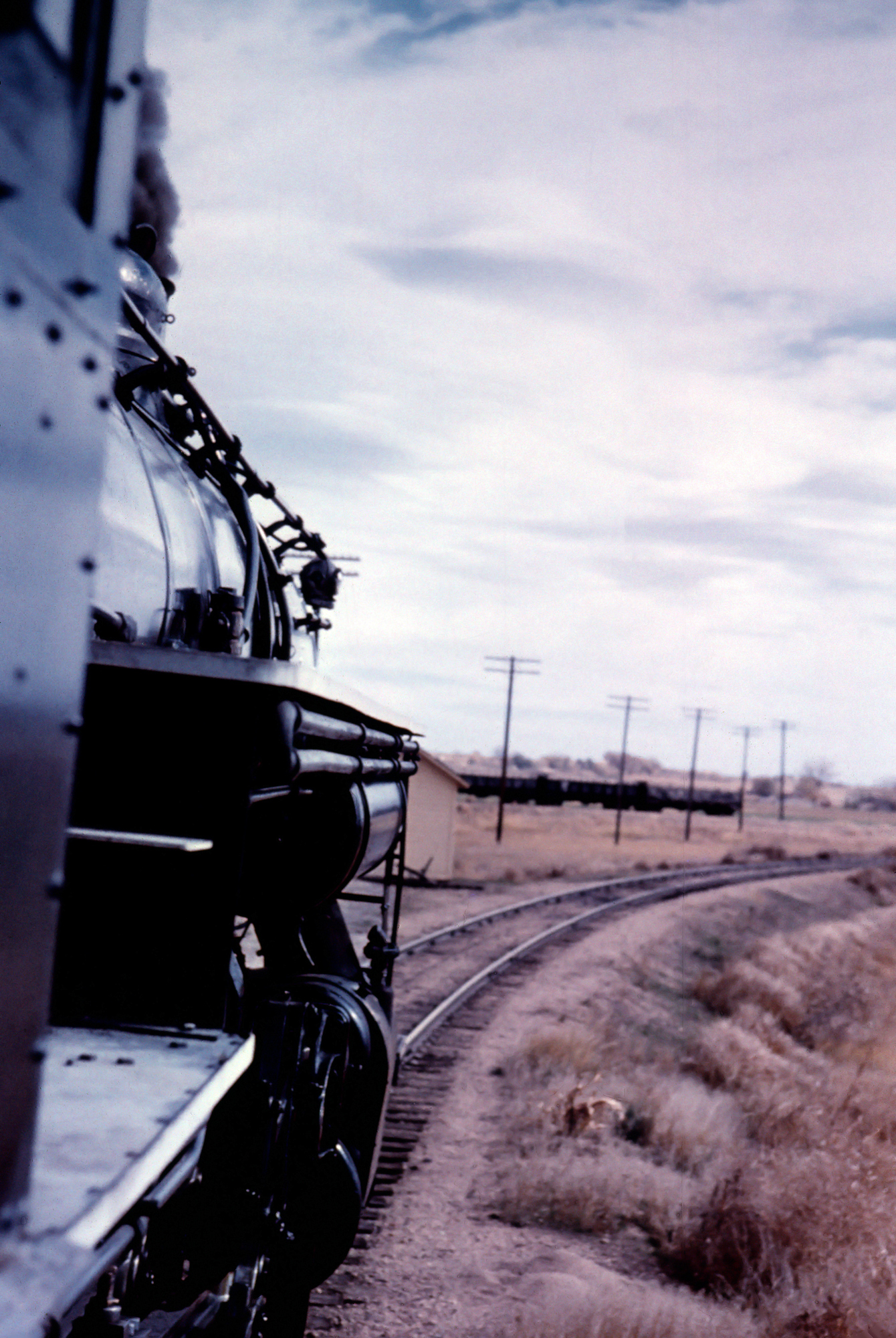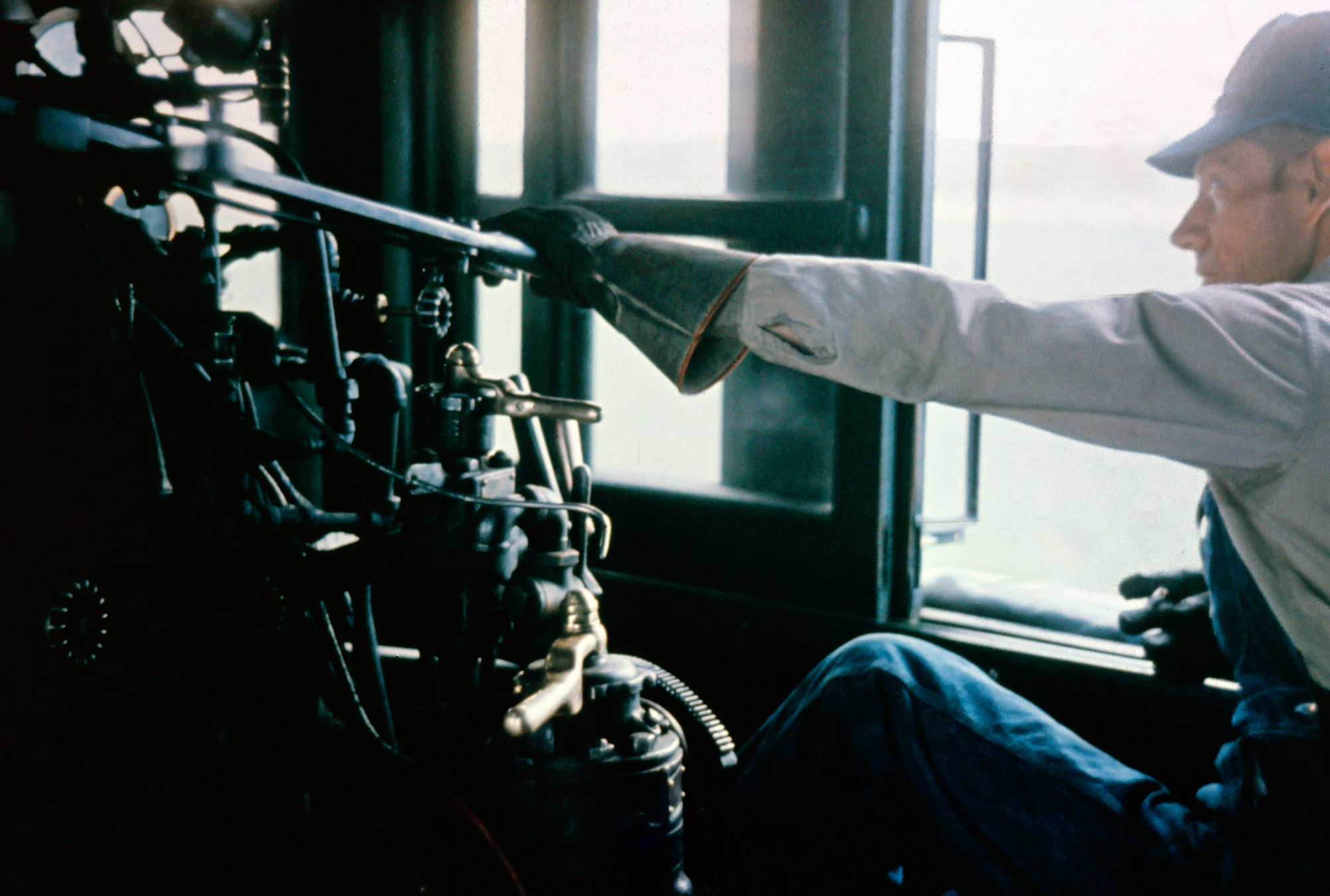- Home ›
- Jobs ›
- Train Engineer
Train Engineer: Background and Overview
Last revised: November 7, 2024
By: Adam Burns
The train engineer has been an integral aspect of railroading since the first steam locomotive was tested on the Delaware & Hudson in 1829. In today's industry this job has remained relatively unchanged in nearly two centuries.
There has been one significant difference, however; modern advances in electronics and computers have largely replaced the need to operate locomotives through only skilled, operational experience.
This has allowed expedient training and railroads to place a qualified train engineer in the cab much more quickly than years ago.
In any event, their primary job description has remained unchanged; safely operate the locomotive(s) and accompanying train from Point A to Point B.
The train engineer is the senior position in the cab although the conductor has primary authority over the train itself. As such, your base salary as an engineer begins in the $50,000's, with many earning over $100,000 following several years in the industry.
If you are interested in becoming an engineer and have never worked in the industry the position is only gained through seniority (at the very least Class I railroads, for instance, require a number of years working as a conductor before obtaining the position of engineer as full-time job) and once offered, you must accept it.
 Taken from the engineer's side of the cab, an Erie Lackawanna F7A approaches the depot in the small community of Cresco, Pennsylvania heading east over the old Delaware, Lackawanna & Western during the winter of 1962. Today, the tracks are still operated by short line Delaware-Lackawanna while the building is now the Cresco Station Museum. Author's collection.
Taken from the engineer's side of the cab, an Erie Lackawanna F7A approaches the depot in the small community of Cresco, Pennsylvania heading east over the old Delaware, Lackawanna & Western during the winter of 1962. Today, the tracks are still operated by short line Delaware-Lackawanna while the building is now the Cresco Station Museum. Author's collection.The train engineer has experienced a great deal of technological change during the industry's nearly 200-year history.
However, as Brian Solomon notes in this book, "Working On The Railroad," the operational aspects of the job have largely remained unchanged and considerable skill is required in easing a heavy freight, weighing thousands of tons, down a steep grade safely.
Since the industry's beginning, from the "Tom Thumb" to the popular 4-4-0 "American," engineers have been needed to handle the locomotive and control a train's movement over the road.
Engineers have been known by a number of names over the years such as hoggers and hostelers (this latter name refers only to the person who moves locomotives in/out of a roundhouse and around the yard, readying it for its daily duties) and they have historically received the most recognition as the coveted position of train operations.
It takes one years to become a skilled engineer and obtain just the right touch to safely control a train.
 Taken from the engineer's side of the cab, an Erie Lackawanna mail/express approaches, led by FT's. Winter, 1962. Author's collection.
Taken from the engineer's side of the cab, an Erie Lackawanna mail/express approaches, led by FT's. Winter, 1962. Author's collection.Historically, the position has been one of the most difficult, magnified during the steam era. These locomotives were complicated, tricky, and cantankerous machines.
As every engineer will attest, each had its own personality, requiring skill and years of experience to operate effectively. Back in those times a hogger had a long list of responsibilities from proper steam pressure to fuel requirements.
The latter was the fireman's job and it took a team effort to maintain efficient operation. It was said a good engineer held just the right touch at the throttle and never caused the wheels to slip when starting from a dead stop.
Perhaps most impressive is that all of this was performed by only muscle memory human skill, long before the advent of computers.
A train engineer's early tools were few; a throttle to control steam flow from the boiler to cylinders, the "Johnson Bar" to regulate the valves (which controlled the locomotive's speed and direction), and an engine brake.
In time, more safety features found their way into the cab including a ringing bell to warn the surrounding public of a train's approach (usually at slower speeds), a whistle for even greater warning effect from afar, and the advent of air brakes.
The latter device was one of the industry's great innovations, enabling the engineer to quickly apply brakes throughout the train via compressed air instead of relying upon one or more brakeman to do so manually from each car (a tedious, time-consuming process that injured/killed many brakemen and led to numerous derailments/collisions).
Further advancements during the 20th century, such as automatic water pumps and feedwater heaters, provided for more efficient operations although the general principles of operating the locomotive remained the same.
The engineers of yore, who witnessed the transition from steam to diesel, often had the same or similar feelings towards each motive power type.
 An engineer's view from Great Western Railway Of Colorado 2-10-0 #90 in the fall of 1960. The locomotive was still in service at this time hauling sugar beets along the railroad's main line between Longmont, Loveland, and Eaton. Today, it is well known hauling tourists on the Strasburg Railroad in Pennsylvania. A.C. Kalmbach photo. American-Rails.com collection.
An engineer's view from Great Western Railway Of Colorado 2-10-0 #90 in the fall of 1960. The locomotive was still in service at this time hauling sugar beets along the railroad's main line between Longmont, Loveland, and Eaton. Today, it is well known hauling tourists on the Strasburg Railroad in Pennsylvania. A.C. Kalmbach photo. American-Rails.com collection.A diesel was a far cleaner machine, and even first-generation models such as Electro-Motive's F7 and GP7, provided a much more climate-controlled environment than any steamer could offer.
In addition, they were far more powerful; while a single diesel unit could not out muscle a large steamer on its own, such as Union Pacific's 4-8-8-4 "Big Boy," their ability to operate in-tandem with multiple units gave them a significant edge over their counterparts.
However, diesels had no personality, particularly in our present-day computer age that began with second-generation variants.
As the years passed, they found they had less and less control while the train was in service with computers now monitoring virtually every part of a locomotive's performance.
Perhaps train engineer George Kowanski, who began his career on Penn Central on January 5, 1971, stated it best in Mr Solomon's book:
"I've worked on GG1's and E8's and none are even close by comparison. With a GG1, you were an extension of the machine.
There was a level of nuance and you needed to concentrate on what you were doing. When you ran these machines you could feel what they did in the seat of your pants. It was an incredible experience.
The guys really prided themselves on train handling. With the newer trains, you do not have the freedom of control that you once had.
A lot of things are done by the computer for you and it's more difficult to run the trains smoothly. You no longer need to have the level of skill that you used to have. Now the computer does it for you.
Back then you had to learn more to run well. The job has been dumbed down and it's not the same anymore. It's much easier."
 The engineer of Great Western Railway of Colorado 2-10-0 #90 keeps a close eye on his gauges while hauling sugar beets in the fall of 1960. This is an extinct craft in modern railroading but still alive and well at various heritage railroads which operate historic steam locomotives. A.C. Kalmbach photo. American-Rails.com collection.
The engineer of Great Western Railway of Colorado 2-10-0 #90 keeps a close eye on his gauges while hauling sugar beets in the fall of 1960. This is an extinct craft in modern railroading but still alive and well at various heritage railroads which operate historic steam locomotives. A.C. Kalmbach photo. American-Rails.com collection.The differences in steam and diesel operation were vast and railroads spent a great deal of time training crews to operate the latter during the transition period.
The locomotive is equipped with a stepped, or notched, throttle ranging from one through eight. Since a diesel is essentially a self-contained electric it is equipped with an ammeter which shows the level of current being fed to the traction motors.
The train engineer uses this device to make sure he or she is not overloading them and causing critical damage to the components (although overloading is usually required when first starting from a dead stop).
With the advent of computers these now largely also control the generator's electrical flow to the motors although the human element has not entirely been lost.
While skill is no longer necessary in every aspect of train handling there is still no substitute for experience.
As another engineer, Doug Riddell, states, "Anyone can run a train [although] the tough part is starting and stopping it." Today's train engineers, of course, do not have to worry about such things as steam pressure and feathering the throttle.
However, they still have numerous issues to be concerned with including wheel slippage, when to apply dynamic braking, what the on-board computers are telling them, and that all locomotives (if more than one) are functioning correctly.
Aside from these kinds of tasks they must remain vigilant of wayside signs, trackside signals, and upcoming grades and curves.
The job can certainly be stressful and one must remain calm and collected under pressure (especially heading up or down steep grades).
Diesels have not only brought about operational changes but also in how train crew's are trained and eventually promoted to engineer.
During the age of steam it normally required years of tutelage for a fireman to gain a permanent right-hand seat on a locomotive (the traditional spot occupied by engineers).
The exact process and time required was different for each railroad. Today, thanks to the diesel's redundancy virtually all but two train crew positions have been eliminated leaving the conductor as the only one left to promote.
Today's Industry
Despite the improved technologies allowing for safer train handling, more efficient operations, and powerful locomotives there is simply no substitute for experience.
This is especially true in braking as a train engineer needs to properly know how to manage a 14,000-ton freight down a 2%+ grade safely while also understanding the intricacies of working the slack out of his/her train without damaging drawbars or lading.
Simulators can mimic this in some ways but there is still nothing like being in the seat.
As Mr. Solomon perfectly points out, "Many books have been written about the use of the air brake, but the nuance of braking technique is something that must be learned through experience."
Aside from controlling the train engineers must also be intimating familiar with the territory they operate. As one engineer stated, "In regards to train handling on the road, you have to think so many miles ahead."
Put another way, a road foreman at BNSF noted that it is more important for an engineer to know his/her territory than his locomotive.
In addition, you must also be keenly aware your train's exact location is at all times along any section of track, from the last car to what lies just ahead.
You will now find all railroads providing their own training programs, requiring students to spend many months on simulators and long hours of study before they are federally licensed as engineers.
It has allowed the training process to be greatly expedited although nothing can replace experience. Perhaps the toughest aspect of the job is fighting fatigue.
If you are seriously interested in working within the railroad industry you must be aware that it is not for everyone.
It is quite common to see 12-hour days regularly and, if asked, overtime is not optional (to make sure that you can be reached at any hour of the day you must carry a cell phone).
Because of this, juggling family and life as a railroader can be quite difficult. This is something I would seriously take into consideration before you decide whether to work in the industry.
For instance, I strongly considered doing this myself but after reading about railroad life and talking with those who have experienced it I decided, personally, that it was not for me. However, this is something that only you can decide for yourself or with your loved ones.
There is a reason why railroaders say that railroading becomes a lifestyle, its not just saying! Lastly, it should noted that you can expect a more predictable schedule as you gain seniority.
However, to finally achieve that "9 to 5" workday that many folks take for granted in other lines of work, a railroader can wait 20 years or more to know exactly what time he or she will head into work and return home.
Also, please note that while Class Is typically require you to complete their own train engineer classes and testing to operate their locomotives and trains certifications through particular trade schools, for instance, can allow you to be hired on directly as such.
On that note certifications through schools like the Modoc and/or National Academy of Railroad Sciences are quite valuable especially if you are interested in hiring on with smaller railroads or commuter agencies.
Recent Articles
-
Delaware Interurbans and Streetcars: History, Lines, Photos
Apr 30, 25 02:33 PM
Delaware's Mid-Atlantic location allowed for a handful of local streetcar and interurban systems to develop. -
Oregon Railroad Museums: A Complete Guide
Apr 25, 25 03:11 PM
With its rich tapestry of scenic landscapes and profound historical significance, Oregon possesses several railroad museums that offer insights into the state’s transportation heritage. -
North Carolina Railroad Museums: A Complete Guide
Apr 25, 25 02:56 PM
Today, several museums in North Caorlina preserve its illustrious past, offering visitors a glimpse into the world of railroads with artifacts, model trains, and historic locomotives.

